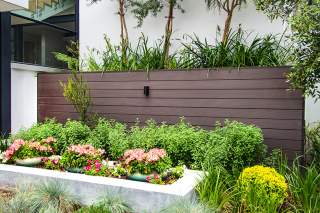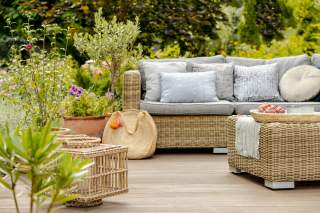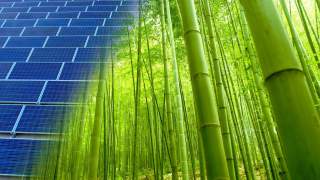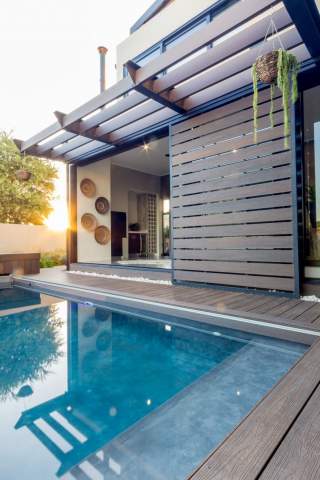how to make living spaces truly come alive
There are many definitions of ‘green’ as it pertains to buildings, but the latest sustainable lifestyle trend toward living walls and living roofs has the ultimate credentials in low-impact living. Rather than being quite literally a statement façade, there are sound reasons for bringing plants into our architectural designs.
Living walls and roofs – otherwise known as green walls and roofs or even ecowalls and ecoroofs – can be either free-standing or attached to wall and roof surfaces, in horizontal or vertical designs and can be planted in soil or use hydroponic systems to provide drip irrigation to the plants selected for the design.
Green walls are typically built using a suitable skeletal structure of supports and watering grid to keep the plants healthy. Choosing the types of plants to hang on green walls is much like choosing a paint colour – only with much more variation possible. The benefits of bringing green walls into living spaces are manifold – from cleaning the air we breathe to reducing ambient noise that would ordinarily bounce off of hard walls, to providing an aesthetically pleasing natural environment.
The temperature fluctuation control, insulation and UV light reflection properties of green roofs are where nature really comes into its own – reducing household energy requirements for climate control in the process. The collective benefit of green roofs in an urban area is the reduction of what is called the ‘heat island effect’ that occurs in cities, where a typical lack of vegetation causes urban areas to be considerably hotter than naturally green areas.
For buildings with suitable rooftops, green roof designs can provide even more benefits, from vegetable planter boxes to natural climate control and a beautiful private recreation space that increases a home’s traditional living area. Adding green walls and green roofs is one way to eliminate ‘sick building syndrome’, which can be summed up as that dreary feeling of living in an artificial environment that is both boring and adds nothing to our health and enjoyment of living. This is especially the case where green walls can be added to office and workspaces.
“Even adding plant boxes, trellises and green trims to a living space can make a considerable difference to one’s quality of life. Not every house is perfectly suited to installing a fully green roof, but we are certainly seeing how property owners are becoming creative with using building materials to bring nature closer to the home,” says the CEO and co-founder of building materials group Eva-Last, Marc Minne.
“Sustainable living elements in homes are now fetching a premium on the market because of the range of features they provide, from energy cost reductions to aesthetic beauty and health benefits. We are pleased to see so many people using Eva-Last’s environmentally sustainable products to form the frameworks for green installations,” he adds.
Eva-Last’s composite building products combine the fast-growing and easily replenished fibres from bamboo with recycled plastic and aluminium materials to provide light, structurally strong and durable building products such as cladding, decking and architectural beams, which are synergistic in designing and creating a green living environment.
“Sustainable elements are changing the face of the urban landscape by providing both new and retrofitted green elements that bring the natural functions of vegetation into our living and social areas. This trend is long overdue, given the benefits greenery has for improving quality of life, decreasing stress and smoothing the flow between natural and built areas to make sure that our cities are sustainable,” says Minne.
The Art of Landscaping
Lockdown restrictions and reluctance of the public to gather in confined spaces have led to some significant changes in the way we work, live and play. One notable trend, that is aligned with the work-from-home ethos over the last 18 months, is landscaping; where entertaining at home has pushed designs toward functionality.
Glenice Ebedes, author of the Gardener’s Guide to Indigenous Garden Plants of Southern Africa and the owner of Grounded Landscaping, says with people spending more time at home, requests for picture gardens have all but disappeared. Instead, customers want living spaces incorporating features for entertainment such as seating and fire pits.
In many ways, the pandemic served to accelerate the incorporation of certain materials and products in the same way that it ushered consumers toward digital channels. As the world increasingly considers sustainability above everything else, the availability and usage of water-wise and low-maintenance plants and materials has gained momentum.
“The most common requests now are for indigenous and water-wise gardens. Also, where it used to be a case of simply putting plants into the garden, people are now considering much more carefully how their gardens will be used,” says Ebedes.
“On the building materials front, there is certainly a much wider range of materials available than there was a decade ago. Just like with the plants they are requesting, people are seeking sustainability and durability of products put into their living spaces,” she adds.
While some people are resolute about the use of real timber in their gardens, there are pros and cons to any approach and landscapers must now present a wider variety of choices to customers than ever before. “The whole look and feel of what can work in a garden is changing,” says Ebedes.
There are certainly more ways to use building materials in the modern context. As older suburbs with large yards and swimming pools give way to smaller, denser living arrangements in secure estates or complexes, Ebedes says screening is a common request. “Now that people are living much closer to each other and being forced to entertain at home more, due to Covid-19, privacy is a big driver behind most garden designs,” she says.
Marc Minne, CEO and co-founder of building materials company Eva-Last, says this is consistent with what suppliers have seen in the market. “This is a very exciting time to be providing composite building materials that are pushing technical boundaries. Traditional materials like timber have remained fairly stagnant in their application and required maintenance, where the incorporation of composite materials has really broadened the uses for building materials. Advancements in finishes, structural performance and reduced weight of composite materials has seen landscaping designs explode with possibilities,” says Minne.
“Where landscapers used to be restrained by the capabilities of materials, it is now possible to be genuinely creative in establishing a flow and aesthetic from indoors to outdoors to create the ultimate continuous living space for home entertainment comfort. The homeowner also benefits from the low maintenance requirements of composite materials, and therefore can spend more time enjoying their outdoor living spaces rather than maintaining them,” he adds.
Dewald van Zyl, project administrator for Living Green Landscapes, says a few years ago most landscaping requests were for themed gardens, such as English, Balinese or Japanese. “This has changed significantly and quickly to requests for water-wise, low-maintenance gardens with plants that are easier to come by. The underlying change behind this trend is the Covid-19 effect. Where customers would arrange for landscaping but seldom even be at the premises while we were busy, they are now taking much closer interest in their gardens,” he says.
“About 90% of the time we are asked to install bomas and entertainment areas now, while we used to get asked for decorative landscaping. It shows a trend toward functional and constructive landscaping – we're asked to integrate the garden into the entertainment features rather than the other way around. No more lawns and flower gardens.”
In terms of sustainability, Van Zyl says most garden designs are cost-driven. “Though the water-wise and indigenous trend is clear, this is often because of the shift toward eco-estate living, where residents need to align with estate landscaping policies. This comes with the benefits of low maintenance and costs.”
Although he is often asked to incorporate herb gardens, raised beds or container gardens into designs, this does not mean customers are suddenly farming at home, Van Zyl adds. “It may be an upcoming trend, but generally these gardens are being designed with entertainment in mind, rather than the hard work it takes to maintain a productive permaculture garden.”
Spring Month is Green Month - Preserve Our Trees!
In South Africa, September celebrates a number of significant events including Arbor Week, with the Department of Agriculture, Land Reform and Rural Development (DALRR) acting as the country’s champion of indigenous forests and trees.
September also sees the World Environmental Health Day and other international reminders of our need to manage our natural resources sustainably and combat accelerating climate change.
The DALRR has called for the public and organisations to get involved in greening their communities and partnering with local government and community-based organisations to coordinate the planting, care and management of all vegetation across urban and rural areas.
The department notes that trees provide more than just ornamental beauty in our open spaces. They provide benefits such as building materials, paper, fibre, oils, gums, syrups, pharmaceutical products, fruit and nuts while also preventing soil erosion. Trees also produce oxygen while using up environmentally detrimental carbon dioxide – they are the filters of our planet.
Incredibly, trees also provide rich nutrients for our soil through fallen leaves, they reduce flooding from rainfall run-off, they lessen sound pollution by deflecting sound waves, act as a windbreak and insulator during harsh weather, as well as providing habitats for wildlife.
In these ways, trees help to not only clean our air, but to reduce our energy costs, improve the productivity of our soils, preserve water supplies and contribute to a beautiful, liveable planet. According to Forestry South Africa, a forest producing 10m3 of wood per year will remove the carbon from the equivalent of 14 million m3 of air each year.
Hardwood trees grow extremely slowly and can reach tremendous sizes – capable of doing incredible work for our environment and impossible to replace in their function. Nathan Chapman, co-founder of sustainable building materials group Eva-Last, says this is why the industry needs to champion the use of alternative materials that protect our natural forests.
“Years ago, timber was in favour in construction and architecture for its look and feel, but it is clear that environmental sustainability and climate change imperatives outweigh any possible aesthetic benefits of using natural timber. At the same time, composite products for decking, cladding and other architectural finishes have come such a long way that they give away nothing in look and feel to real wood. There really is no reason to select timber any more,” says Chapman.
Eva-Last’s range of decking, cladding and beams includes some of the most advanced profile technology on the market. “It’s not just about the look and feel of the product. Over the last two decades we have introduced several patents that improve profile strength across framework spans while reducing profile weight and increasing product longevity significantly, even in the harshest environmental conditions. Our composite alternatives are also highly rated for fire resistance and non-slip surfaces, so in all ways these products are advancements on what timber can offer as a building material,” says Chapman.
He says warranties on Eva-Last products like the Apex range have expanded to cover three decades of use. “This is just unthinkable with real wood, which requires constant maintenance and upkeep, as well as being susceptible to warping, cracking, fading, staining, moisture ingress and destruction by environmental threats like termites. Now, decking, fencing, screening and railing can be put up and left up, requiring nothing more than the occasional clean, as a feature of a property that will not deteriorate or look scruffy in a few years.”
Eva-Last’s Apex, Infinity and Eva-Tech decking ranges are also secured with the company’s proprietary fasteners, under the Hulk brand, which ensure a consistent, flawless and invisible fastening finish. “This eliminates another key drawback of natural timber, which is that it is prone to cracking and coming loose from its fasteners over time, through weather cycles and under heavy use. With some of the most natural-looking, lightest and most durable products ever created available to customers these days, a truly sustainable approach to beautiful architecture and construction is possible – with none of the drawbacks,” says Chapman.
Spring Cleaning your Deck for Summer
With summer on our doorstep, this is the time of year when your deck will be used the most. South Africans love to enjoy the outdoors and entertain at home, but even with high foot traffic and activity a composite deck can be returned to first-day appearance in just a few quick minutes.
Caring for a composite deck is a little different from maintenance for a traditional all-timber deck. In general, timber will need to be refinished; sanded, stained and sealed every few years to avoid warping, cracking and splintering. Wooden deck boards are also much more prone to scratches and let water into tiny spaces, causing decomposition and discoloration. The lifespan of a timber deck is typically not longer than ten years.
Composite decking boards, on the other hand, typically feature a hard cap made from recycled plastics that prevents scratching, splitting, warping and discoloration from stains while standing up to the elements for much longer. A composite deck from Eva-Last, which features a solid pressed bamboo polymer or PVC core, carries a warranty for literally decades and never needs anything more than a regular sweep and a clean.
The key to showing off a brilliant, spotless deck is simple, quick and regular gentle cleans. Eva-Last’s finishes are designed to endure the toughest of environmental and usage conditions – even in tropical, humid coastal zones – repelling everything from heat and rain to stains and mould, but even the hardiest materials need a little attention from time to time.
To return your deck to tip-top shape following winter, here are some simple tips for showing off your prized landscaping and décor materials with the least effort:
1) First, lightly sweep the deck to get rid of any loose fallen debris.
2) In almost all cases, nothing more than some soapy water and hard nylon-bristle household broom or brush will be required to maintain your decking. Where there is localised fatty build-up from a braai or spillage, a brush can be used for a light scrub with soapy water (a mild solution of dishwashing liquid will work just fine to dissolve fatty deposits).
3) There is no need to use bleach-based or ammonia-based products. In case you are unsure, anything with bleach in it will likely list some form of chlorine or “hypochlorite” among its ingredients.
4) While there is almost never a need to use a scourer or abrasive of any kind on a composite deck finish, on Eva-Last’s Eva-Tech range some 40-grit sandpaper or even a regular pot scourer can be rubbed gently with the grain to remove very stubborn stains or marks. The sanded area will be slightly lighter for a few days, but will quickly return to its usual shade after a few days in the sun. Stains will never penetrate into the actual board under the finish, so only a light scrub is necessary.
5) Heat and/or steam are never necessary to clean an Eva-Last product. Usually, even dreaded stain causes like red wine can be wiped up easily with nothing more than a cloth and water.
6) Once a deck has been washed or lightly scrubbed of all dirt, only a hose or clean water is required for a final rinse. High water pressure is not needed, though your deck will happily cope with that.
7) All Eva-Last materials can be cleaned in this way – decking boards, cladding, railings and beams will all look their best after a quick and gentle clean, whether indoors or outdoors.
While most cleaning is hassle-free and quick, some situations may be out of the norm. We’re always on call to help, so if there’s a cleaning challenge that looks unusually difficult, please contact Eva-Last for the best advice.
Celebrating Women in the Building Materials Industry
Eva-Last celebrates women in the building materials industry The construction, building materials and engineering fields have for years carried with them the stigma of being male-dominated industries. For three women working at building materials group Eva-Last, however, passion is purpose and outdated perceptions will not stand in their way.
Shelley Galliver, Eva-Last’s marketing director, has more than two decades experience in the building materials industry and says the relatively specialised nature of the industry has worked in her favour. “Building materials is a niche market, so if you can grow your profile and credentials in the industry, there are opportunities out there.”
Galliver obtained a degree in marketing and started her career in various positions at PG Bison before becoming a brand manager. “That was where I found my lane – I just loved my job because it required a deep understanding of all aspects of the product, including technical and production, to better market the offering. I was soon overseeing most of the company’s brand portfolio.”
Moving to Alpha Cement, as a marketing manager, she expanded her responsibilities from brand management to full marketing management; first in a division and ultimately across the whole business; and then to the Dawn Group – as marketing director for brands such as Cobra taps and mixers and other strategic marketing director roles in the group. Galliver then took a brief sidestep into explosives with Maxam. “By that stage I had developed a real love and passion for building materials, so when Eva-Last came calling I was ready to move back into the industry.”
Throughout her career Galliver has worked in male-dominated workplaces, and she believes some companies can make the mistake of reinforcing perceptions about the gender divide even when they set out to address workplace equality. “By hiring men for technical positions and women for less hands-on work, barriers can remain in place. It’s really about what you can do in the role. I can honestly say that, given the opportunities I was given, if you are competent, confident and can demonstrate that you’re there to add value, you are treated equally.”
Working in marketing has provided a double barrier to being taken seriously. “A lot of people don’t understand the strategic role of marketing. Once they see that you understand all aspects of the business and can help drive strategy, you quickly gain their respect. Anyone in a technical field – even in marketing – has to understand the various routes to market and the different requirements of the channels to be able to market their products or brands effectively. This is what I find exciting about the industry – it is so diversified, you are marketing your brand to people who are often not your direct customers, but whose needs must be understood for your brand to be the product of choice,” says Galliver.
Nikita Norman, Eva-Last’s Durban branch manager, says from high school to her family’s technical leanings – even including completing a welding course during her studies – made her aspire to study engineering or architecture. A qualification in architectural draughting got her into the company in its early days. “I was one of the first women here and we all had to fill many roles at once. I was draughting for project installations while also working up new decking board profiles and clips, while also being involved in sales. I’d also pick up phones and handle walk-in customers, which made me work on parts of my personality to become better at sales.”
Like Galliver, Norman loved being at the centre of the business. “From architecture to sales is quite a move, but it meant I had to understand the business and our products intimately. I needed to be able to answer any questions a customer might have. Many people think women are not technically inclined, but my sister is an engineer and I believe women should not allow themselves to be steered by the attitudes of others. It can be challenging to work in this industry, but we have an all-female team of three here in Durban and for the most part our contractors and customers simply want someone who is technically minded and can solve their problems.”
Norman says a passion for the products she works with goes a long way. “The company is vibrant and has a lot of momentum and innovative sparkle. The industry in general is also evolving very quickly in terms of the products being developed and how architects are putting them to use. To be at the forefront of technical developments in the industry is exciting and would hate to have missed that opportunity by taking a ‘safer’ route in my career.”
Caitlynne Collender, a research and design product manager at Eva-Last, also took the draughting route into the industry and has remained on the technical development side rather than sales. “I started helping to draw up new products, which became my main focus rather than project designs. I worked directly with the research and development team, bringing in new technologies, and we have been changing the industry with our patents, which is very exciting.”
Intimately involved in the development of Eva-Last’s Hulk fasteners range, Collender says she also benefited from a family used to designing and building things. “My dad is very hands-on. I grew up around yachts and boats, fixing and building things. I was also friends with many people who worked in technical trades, and draughting is one of my core passions. The company lets me do just that and provides the tools for me to do it, so I’ve been very fortunate. I’ve also worked with many men who have daughters, so they’ve always been comfortable around women.”
It hasn’t always been that way. “When I showed up to register for a technical college course, the man who would go on to be my teacher asked me if I was there to register my husband. That stank. Then I was also overlooked at graduation where all my male peers who received fewer distinctions than I did were celebrated. I think the industry is catching up and making things right, and we are seeing fewer women pigeon-holed into roles. The women at Eva-Last are raring to take opportunities and run with them,” Collender says.
Advice from the Eva-Last team is to not take a backseat. “Be willing to get involved and understand all the technical aspects of the business and product. That’s the baseline for being able to work with highly technical people in engineering teams. You need to speak their language,” says Galliver.
“Never give up. If you have a passion for a technical field, just forge ahead. You need to take chances because this is a rewarding and interesting field,” says Norman. “Don’t listen to anyone else – if you get a gap, take it and do what you need to do. You can learn many things online and upskill yourself without depending on others who might slow you down. I’m very grateful for the opportunities I have been given, but remember to speak up for yourself,” Collender adds.
Beautiful Durability - Lifespan Versatile Composite Architectural Beams
Exposed posts, beams and trusses have been used for centuries to provide aesthetically pleasing and functional features to architecture – particularly for vaulted ceilings. Though the traditional materials used for such architectural framing included hardwoods, their weight, susceptibility to decay and environmental impact have encouraged architects to look for sustainable alternatives.
The innovation behind Eva-Last’s Lifespan range of forest-friendly trussing materials has combined market-leading composite materials with lightweight aluminium components to create incredibly versatile profiles to complement any space.
Lifespan brings together a surface with a natural timber appearance and the concealed high-performance longevity of aluminium with none of the drawbacks of wood; warping, cracking, fading, splitting and susceptibility to environmental conditions.
By installing Lifespan in either vertical or horizontal applications, a commercial or residential space can benefit from the character, visual warmth and aesthetic features, to exude rustic elegance.
Lifespan’s endless versatility also provides design opportunities to create eco-friendly pergolas, cladding, screening, railing and other decorative architectural showpieces that benefit from longevity and performance far superior to natural timber. Lifespan’s span capabilities significantly exceed those of other composite products. With its aluminium hollow core and Eva-Tech composite external layer providing long-lasting protection and a range of attractive finishes, Lifespan comes with a 10-year warranty.
“Through a tri-extrusion process to bond the elements of Lifespan together, this range of products is highly resistant to severe climatic and biodeterioration conditions. Lifespan has been engineered to meet industrial norms and architects have benefited from its light weight, while requiring no reinforcement and less time to install thanks to easier handling. It also requires no maintenance and upkeep, unlike real timber,” says Eva-Last CEO Marc Minne.
A major benefit for all end users is Lifespan’s environmental credentials, making use of recycled materials and solar energy in manufacturing. “Lifespan helps to preserve valuable natural resources while providing finishes and aesthetics that are indistinguishable from the timber appearance we all know and love. This – along with UV resistance for both indoor and outdoor applications – makes Lifespan the ideal choice for any exposed beams and trusses, such as in the post-and-beam loft style,” says Minne.
Underneath its beautiful exterior, Lifespan offers market-leading technical specifications in flexural stability, weather resistance, application opportunities and biodegradation through attack by organisms like termites, fungi and bacteria.







